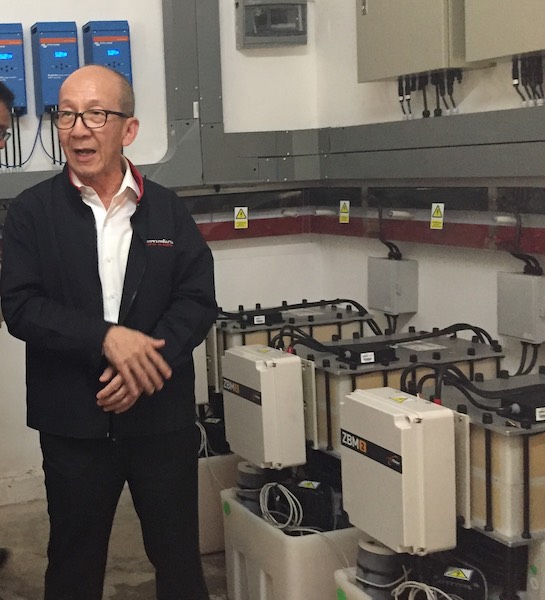 Thailand Energy Minister Dr Siri Jirapongphan with Redflow batteries at Ban Pha DanRedflow ZBM2 zinc-bromine flow batteries are now storing solar energy to provide a reliable power supply for a remote village in mountainous northern Thailand that has long lacked electricity.
Thailand Energy Minister Dr Siri Jirapongphan with Redflow batteries at Ban Pha DanRedflow ZBM2 zinc-bromine flow batteries are now storing solar energy to provide a reliable power supply for a remote village in mountainous northern Thailand that has long lacked electricity.
In a project backed by the Thai Government, the village of Ban Pha Dan in Lamphun province is using solar cells to harvest energy and a high-performance hybrid battery system, including ZBM2s, to store energy for a village microgrid that is separated from the national electricity distribution network.
Ban Pha Dan, 70km south of the northern Thai city of Chiang Mai, is a small village that has lacked access to electricity because it is surrounded by a wildlife reserve where power poles are forbidden. This microgrid project was initiated by Thailand’s Energy Ministry and the Renewable Energy for Sustainable Association with financial support from the Energy Conservation Promotion Fund.
Thailand’s Energy Minister Dr Siri Jirapongphan visited Ban Pha Dan to inspect the new microgrid and energy storage system in mid-January. Later that month, the Thailand National Energy Policy Council, chaired by Prime Minister Prayut Chan-o-cha, approved Thailand’s Power Development Plan, which prioritises the development of renewable energy sources for the period 2018-2037. Dr Jirapongphan said that non-fossil energy would account for 35 per cent of total capacity by 2037.
Redflow Managing Director and CEO Tim Harris said the Ban Pha Dan deployment provided a compelling model for remote communities in both developing and developed countries. “This solar-powered microgrid with energy storage shows how to provide environmentally-friendly energy for remote communities,” he said.
“Without the cost and pollution of diesel generators, this system gives local people access to energy for lighting, refrigeration and water pumps, which significantly improves their quality of life.”

The Ban Pha Dan energy storage system combines 10 Redflow ZBM2 10 kilowatt-hour zinc-bromine flow batteries with three lithium batteries. Redflow’s long-term partner in Thailand, TSUS Group, installed the ZBM2 batteries to store solar-generated energy that powers the community school, town hall and temple while the lithium batteries supply energy for individual houses,each of which uses less than one-fortieth of the daily power consumed in an average Australian house. The locally-produced energy also enables villagers to power water-supply systems for drinking and agriculture.
The energy storage system is installed in a small concrete building next to the town hall. Three large lithium batteries are installed in an airconditioned room to ensure they operate at a safe temperature while, in an adjacent room, the Redflow batteries work safely without the need for air conditioning.
Mr Harris said the success of the Ban Pha Dan system demonstrated the benefits of solar-powered microgrids with energy storage for remote communities in many Redflow target markets, including the Asia-Pacific region, southern Africa and even remote mining communities in Australia. “Just like mobile telephony leapfrogged fixed-line telecommunications in developing countries, microgrids can deliver the benefits of modern technology without the massive infrastructure spend required by grid-based energy utilities,” he said.
“Redflow believes microgrids present a strong market opportunity for our zinc-bromine flow batteries.”
 Redflow batteries with Victron inverter-chargers at Ban Pha Dan Thailand
Redflow batteries with Victron inverter-chargers at Ban Pha Dan Thailand
For media assistance, please call John Harris on +61 8 8431 4000 or email john@impress.com.au.
About Redflow
Redflow Limited, a publicly-listed Australian company (ASX: RFX), produces small 10kWh zinc-bromine flow batteries that tolerate daily hard work in harsh conditions. Marketed as ZCell and ZBM2, Redflow batteries are designed for high cycle-rate, long time-base stationary energy storage applications in the residential, commercial & industrial and telecommunications sectors, and are scalable from a single battery installation through to grid-scale deployments. Redflow batteries are sold, installed and maintained by an international network of energy system integrators. Redflow’s smart, self-protecting batteries offer unique advantages including secure remote management, 100 per cent daily depth of discharge, tolerance of high ambient temperatures, a simple recycling path, no propensity for thermal runaway and sustained energy delivery throughout their operating life.
Related News
- Redflow to miners: Store energy to cut costs Australian energy storage specialist Redflow has advised the country’s beleaguered mining companies to deploy renewable energy with on-site power storage to cut energy costs ...
- Redflow extends battery warranty to 10 years Australian energy storage specialist Redflow Limited today announces that it has extended the warranty for its 10 kilowatt hour (kWh) ZBM2 and ZCell zinc-bromine flow batteries to ...
- Former Santos CEO joins Redflow board New Redflow board member David KnoxAustralian energy storage specialist Redflow Limited has recruited former Santos Managing Director and CEO David Knox to its board of directors a...
- Redflow cashes up to target demand areas Redflow Executive Chairman and CEO Simon Hackett with ZCellAustralian battery company Redflow Limited today unveiled an investment package that will raise $14.5 million to tar...





